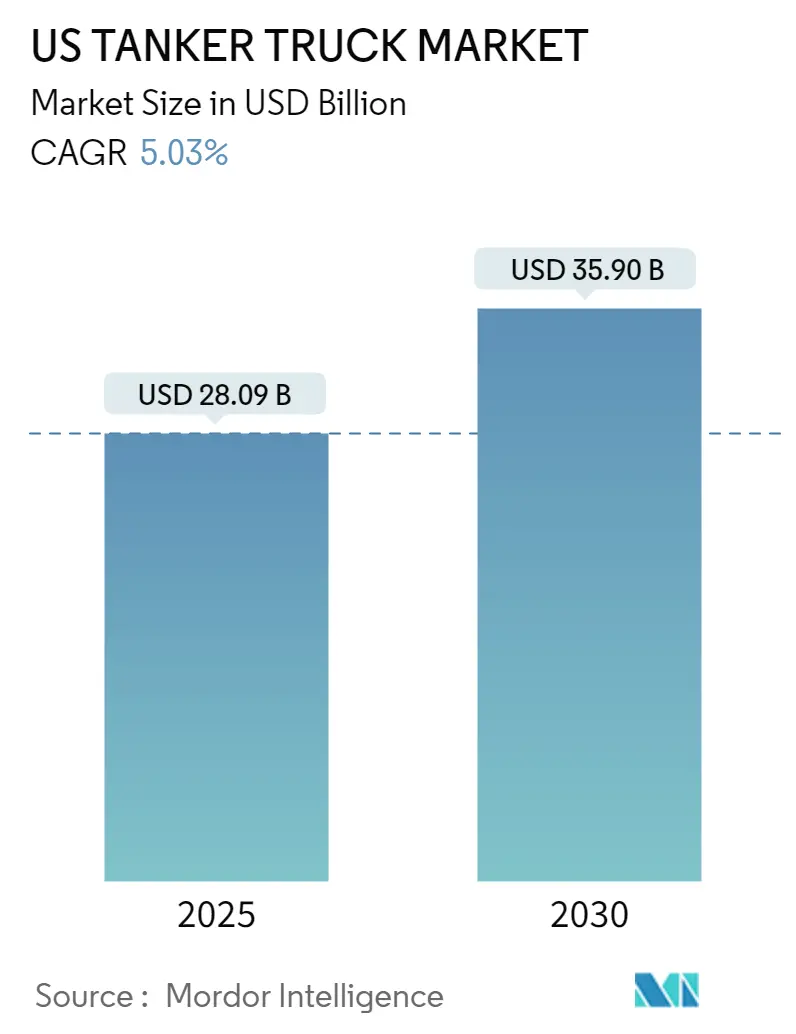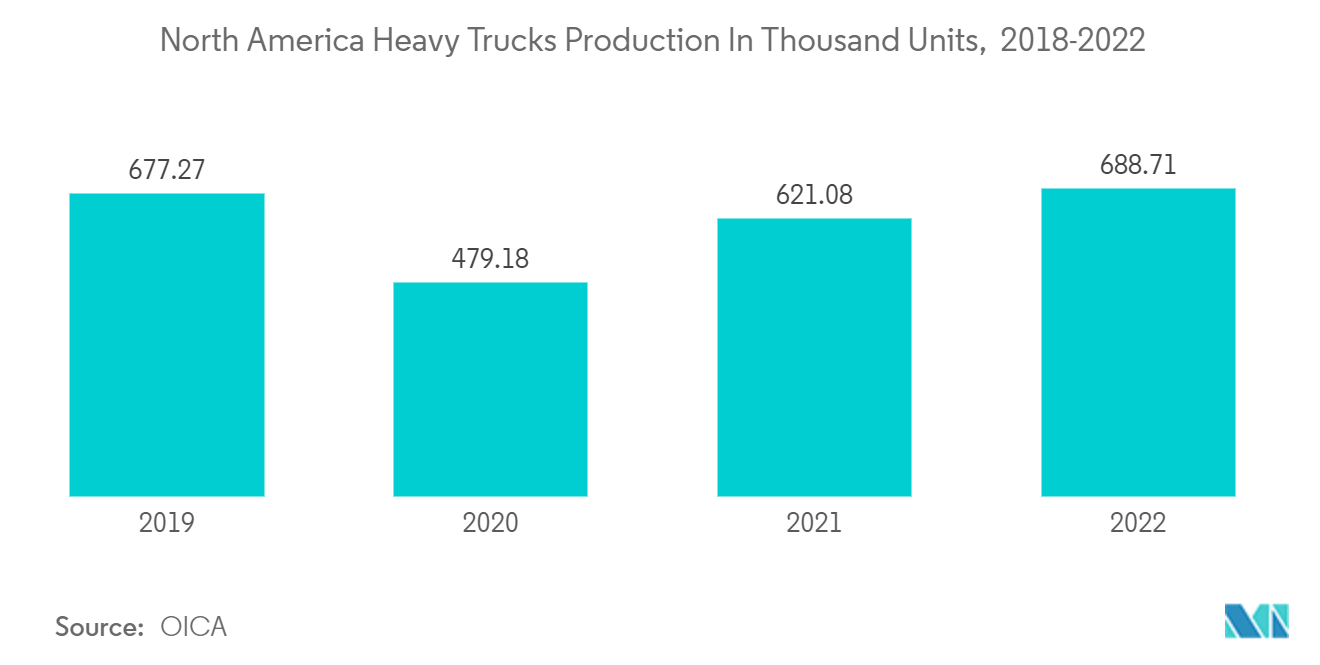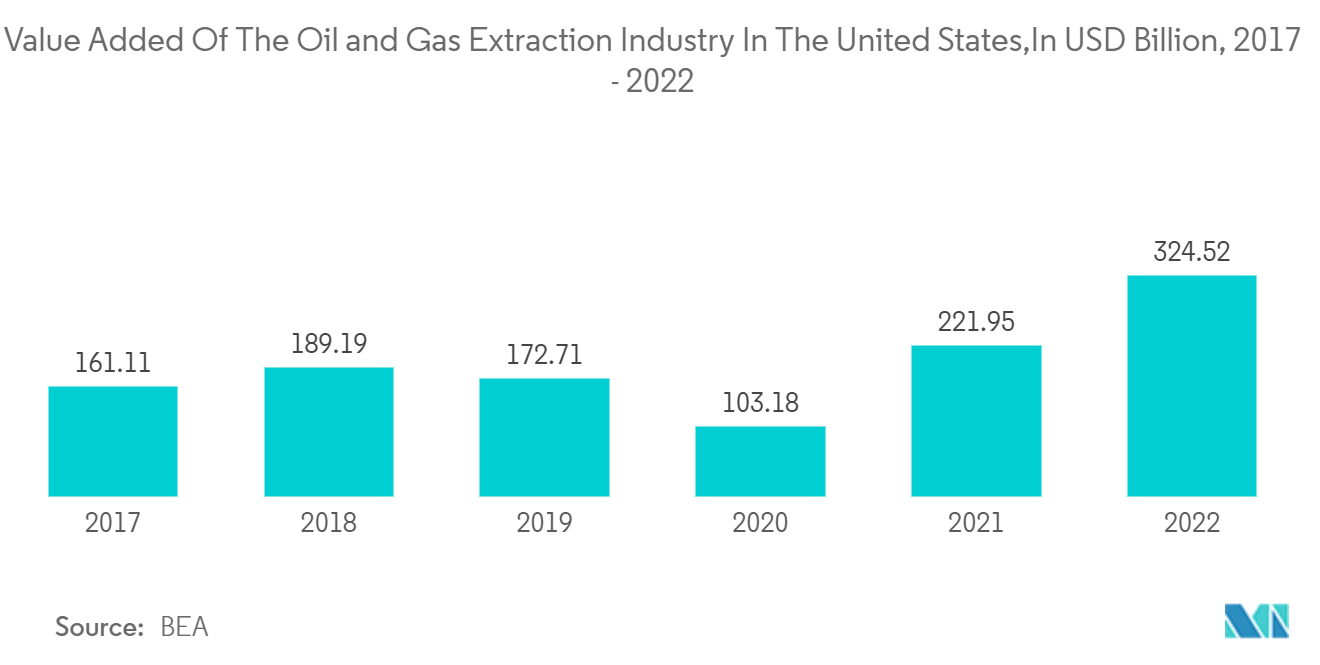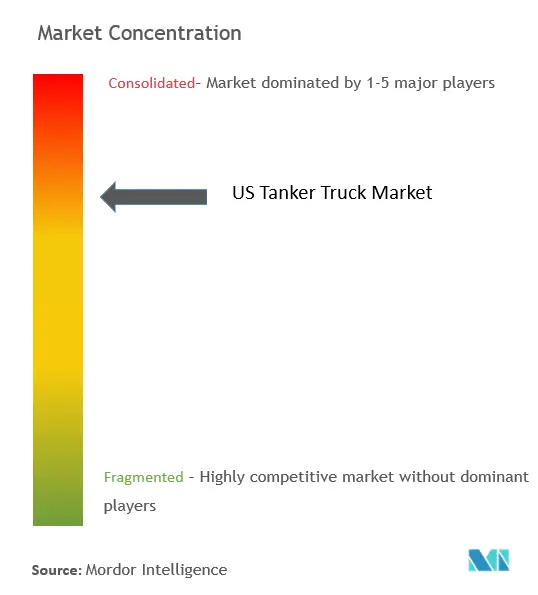US TANKER TRUCK MARKET Size and Share

US TANKER TRUCK MARKET Analysis by Mordor Intelligence
The US TANKER TRUCK MARKET size is estimated at USD 28.09 billion in 2025, and is expected to reach USD 35.90 billion by 2030, at a CAGR of 5.03% during the forecast period (2025-2030).
The tanker truck industry serves a crucial role in transporting various liquids, including petroleum products, chemicals, water, and food substances, across vast distances. The US tanker truck market is influenced by several key drivers, including economic conditions, energy trends, and regulatory frameworks. Fluctuations in oil prices can significantly impact demand for petroleum transportation, affecting tanker truck manufacturers and operators alike.
The tanker truck market is focusing on sustainability and efficiency. Due to the increasing concerns about carbon emissions and environmental impact, stakeholders are seeking ways to reduce fuel consumption and improve overall performance, leading to the adoption of advanced technologies such as aerodynamic designs, lightweight materials, and alternative fuels, enhancing the sustainability of tanker truck operations.
Furthermore, the rise of e-commerce and changing consumer preferences have bolstered the demand for liquid transportation services. From delivering fuel to gas stations to transporting food-grade liquids for online grocery retailers, tanker trucks have a vital role to play in supporting various industries. As the logistics landscape continues to evolve, tanker truck operators are adapting various strategies to meet the demands of a rapidly changing market.
The US tanker truck market presents lucrative opportunities for growth and innovation. With increasing investments in infrastructure development and the adoption of advanced technologies, stakeholders can capitalize on emerging trends to gain a competitive edge. From autonomous driving systems to predictive maintenance solutions, the future of tanker trucking is poised for transformation.
Global US TANKER TRUCK MARKET Trends and Insights
Between 1, 000 Gallons and 4, 000 Gallons Tanker Truck is Dominating the Market
This segment's prevalence reflects a balance between versatility, operational efficiency, and regulatory compliance within the industry. Medium tanker trucks offer a compelling solution for a wide range of liquid transportation needs, spanning industries such as petroleum, chemicals, agriculture, and food and beverage.
One key factor contributing to the dominance of medium-sized tanker trucks is their versatility. With capacities ranging from 1,000 to 4,000 gallons, these trucks strike a balance between payload capacity and maneuverability, making them well-suited for navigating urban environments, rural roads, and highways alike. This versatility allows medium tanker trucks to access a diverse range of delivery locations, from small-scale agricultural operations to large industrial facilities, without compromising on efficiency or accessibility.
Moreover, medium-sized tanker trucks offer operational efficiency advantages that contribute to their market dominance. Compared to larger tanker trucks, which may require specialized handling equipment and infrastructure, medium-sized tankers are more cost-effective to operate and maintain. Their smaller footprint translates to lower fuel consumption, reduced maintenance costs, and increased flexibility in route planning and scheduling. As a result, medium tanker trucks offer a compelling value proposition for fleet operators seeking to optimize operational efficiency and maximize profitability.
Furthermore, the dominance of medium-sized tanker trucks reflects broader industry trends and market dynamics. The modular design of medium tanker trucks facilitates customization and adaptation to specific customer requirements, enabling manufacturers to cater to diverse market segments and niche applications. Whether transporting fuel, chemicals, water, or food-grade liquids, medium-sized tanker trucks offer a versatile platform that can be tailored to meet the unique needs of different industries and end-users.
Additionally, the prevalence of medium-sized tanker trucks underscores the importance of flexibility and scalability in the liquid transportation industry. As market conditions evolve and customer demand fluctuates, fleet operators require agile and adaptable transportation solutions that can respond to changing needs and dynamic market dynamics. Medium-sized tanker trucks provide a scalable platform that can be easily integrated into existing fleets or expanded to accommodate growing business volumes, offering operators the flexibility to adjust capacity and resources as needed.

Oil and Gas Industry Dominating The Market
The US tanker truck market reveals the significant dominance of the oil and gas industry, which plays a pivotal role in shaping the demand for liquid transportation services. This dominance stems from several key factors that highlight the industry's reliance on tanker trucks for the transportation of crude oil, refined petroleum products, and other liquid commodities.
The United States is one of the world's leading producers and consumers of oil and natural gas, with extensive networks of extraction sites, refineries, and distribution terminals spanning vast geographic regions. As a result, the demand for tanker trucks to transport crude oil from drilling sites to refineries and refined products from refineries to distribution points remains consistently high.
Moreover, the dynamic nature of the oil and gas market necessitates flexible and reliable transportation solutions, further underscoring the importance of tanker trucks. Fluctuations in oil prices, changes in production levels, and shifts in demand patterns require agile logistics capabilities that can ensure timely and efficient delivery of liquid commodities to the market.
Tanker trucks offer the flexibility and responsiveness needed to adapt to changing market conditions, enabling oil and gas companies to maintain supply chain continuity and meet customer demand.
The strategic importance of tanker trucks in the oil and gas industry is also evident in the diverse range of liquid commodities transported. In addition to crude oil and refined petroleum products, tanker trucks are utilized in transporting various specialized liquids, including natural gas liquids (NGLs), liquefied petroleum gas (LPG), chemicals, and industrial gases. These diverse commodities serve critical roles in fueling industrial processes, powering vehicles and machinery, and supporting economic activities across multiple sectors.
The geographic dispersion of oil and gas production sites and distribution facilities necessitates extensive transportation networks, with tanker trucks serving as a vital link in the supply chain.
By leveraging tanker trucks' flexibility, reliability and safety features, the oil and gas industry continues to uphold its position as a dominant force in the US tanker truck market, driving demand for liquid transportation services and shaping industry trends for the coming years.

Competitive Landscape
The US Tanker truck market is moderately consolidated with players like Volvo Group, MAN Truck & Bus AG, Mercedes (Daimler), Iveco, Scania AB, Freightliner Trucks, and others.
Players either follow a constructive alliance approach or aggressively launch new trucks in the market. For instance:
• In January 2024, Volvo Trucks introduced a new heavy-duty truck platform tailored for the North American market. It launched a fresh heavy-duty truck lineup for Europe, Australia, and various markets across Asia and Africa.
o These new models prioritize energy efficiency, featuring options such as electric and renewable fuel-powered trucks. These advancements are aimed at lowering CO2 emissions, moving the company closer to its goal of achieving a net-zero emission product range by 2040.
US TANKER TRUCK Industry Leaders
MAN Truck & Bus AG
Iveco
Mercedes (Daimler)
Volvo Group
Scania AB
- *Disclaimer: Major Players sorted in no particular order

Recent Industry Developments
- In December 2023, Trina Solar, a provider of intelligent solar solutions, introduced its latest lineup of Trina-branded trucks to transport photovoltaic (PV) modules for large-scale solar projects across the United States.
- This initiative signifies the initial stage of Trina's fleet strategy, with plans underway to transition to electric vehicles for deliveries starting in 2024. Currently, Trina utilizes its Trina Truck for the delivery of materials to over 35% of its utility projects, with sightings of these trucks on major highways across more than ten states in the United States.
- In April 2023, Daimler Truck, a manufacturer of commercial vehicles, unveiled Rizon, a new brand of medium-duty electric trucks specifically designed for the US market.
Global US TANKER TRUCK MARKET Report Scope
A tanker truck, known as a tanker lorry in some regions, is a specialized vehicle designed for transporting liquids in large quantities. These trucks typically feature a cylindrical tank mounted on a chassis, allowing for the safe and efficient transportation of various substances such as petroleum products, chemicals, water, milk, and food-grade liquids.
The market is segmented by capacity (less than 1,000 gallons, between 1,000 gallons and 4,000 gallons, and more than 4,000 gallons, by sector type (oil and gas industry, food sector, healthcare sector, water treatment facilities, chemical industry, construction, waste management, and other sectors).
| Less Than 1, 000 Gallons |
| Between 1, 000 Gallons and 4, 000 Gallons |
| More Than 4, 000 Gallons |
| Oil and Gas Industry |
| Food Sector |
| Healthcare Sector |
| Water Treatment Facilities |
| Chemical Industry |
| Construction |
| Waste Management |
| Other Sectors |
| By Capacity | Less Than 1, 000 Gallons |
| Between 1, 000 Gallons and 4, 000 Gallons | |
| More Than 4, 000 Gallons | |
| By Sector Type | Oil and Gas Industry |
| Food Sector | |
| Healthcare Sector | |
| Water Treatment Facilities | |
| Chemical Industry | |
| Construction | |
| Waste Management | |
| Other Sectors |
Key Questions Answered in the Report
How big is the US TANKER TRUCK MARKET?
The US TANKER TRUCK MARKET size is expected to reach USD 28.09 billion in 2025 and grow at a CAGR of 5.03% to reach USD 35.90 billion by 2030.
What is the current US TANKER TRUCK MARKET size?
In 2025, the US TANKER TRUCK MARKET size is expected to reach USD 28.09 billion.
Who are the key players in US TANKER TRUCK MARKET?
MAN Truck & Bus AG, Iveco, Mercedes (Daimler), Volvo Group and Scania AB are the major companies operating in the US TANKER TRUCK MARKET.
Which is the fastest growing region in US TANKER TRUCK MARKET?
Asia Pacific is estimated to grow at the highest CAGR over the forecast period (2025-2030).
Which region has the biggest share in US TANKER TRUCK MARKET?
In 2025, the Asia Pacific accounts for the largest market share in US TANKER TRUCK MARKET.
What years does this US TANKER TRUCK MARKET cover, and what was the market size in 2024?
In 2024, the US TANKER TRUCK MARKET size was estimated at USD 26.68 billion. The report covers the US TANKER TRUCK MARKET historical market size for years: 2019, 2020, 2021, 2022, 2023 and 2024. The report also forecasts the US TANKER TRUCK MARKET size for years: 2025, 2026, 2027, 2028, 2029 and 2030.
Page last updated on:
US TANKER TRUCK MARKET Report
Statistics for the 2025 US TANKER TRUCK MARKET market share, size and revenue growth rate, created by Mordor Intelligence™ Industry Reports. US TANKER TRUCK MARKET analysis includes a market forecast outlook for 2025 to 2030 and historical overview. Get a sample of this industry analysis as a free report PDF download.



